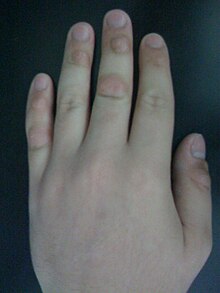| Body-focused repetitive behavior | |
|---|---|
 | |
| Dermatillomania (picking of the skin) of the knuckles (via mouth), illustrating disfiguration of the distal and proximal joints of the middle and little fingers |
Body-focused repetitive behavior (BFRB) is an umbrella name for impulse control[1] behaviors involving compulsively damaging one's physical appearance or causing physical injury.[2]
Body-focused repetitive behavior disorders (BFRBDs) in ICD-11 is in development.[3]
BFRB disorders are currently estimated to be under the obsessive-compulsive spectrum.[4] They are also associated with ADHD and anxiety.
Causes
The cause of BFRBs is unknown.[citation needed]
Emotional variables may have a differential impact on the expression of BFRBs.[5]
Research has suggested that the urge to repetitive self-injury is similar to a body-focused repetitive behavior but others have argued that for some the condition is more akin to a substance abuse disorder.[citation needed]
Researchers are investigating a possible genetic component.[1][6]
Onset
BFRBs most often begin in late childhood or in the early teens.[2]
Diagnosis
Types
The main BFRB disorders are:[4]
- Skin
- Dermatillomania (excoriation disorder), skin picking
- Dermatophagia, skin nibbling
- Mouth
- Morsicatio buccarum, cheek biting
- Morsicatio labiorum, inner lip biting
- Morsicatio linguarum, tongue biting
- Nails
- Onychotillomania, nail picking
- Onychophagia, nail biting
- Nose
- Rhinotillexomania, compulsive nose picking[2]
- Hair
- Trichotillomania, hair pulling
- Trichophagia, hair nibbling
- Trichotemnomania, hair cutting
- Trichoteiromania, hair rubbing
- Eyes
- Mucus fishing syndrome - compulsion to remove or "fish" strands of mucus from the eye
Treatment
Psychotherapy
Treatment can include behavior modification therapy, medication, and family therapy.[1][2] The evidence base criteria for BFRBs is strict and methodical.[7] Individual behavioral therapy has been shown as a "probably effective" evidence-based therapy to help with thumb sucking, and possibly nail biting.[7] Cognitive behavioral therapy was cited as experimental evidence based therapy to treat trichotillomania and nail biting;[7] a systematic review found best evidence for habit reversal training and decoupling.[8] Another form of treatment that focuses on mindfulness, stimuli and rewards has proven effective in some people. However, no treatment was deemed well-established to treat any form of BFRBs.[7]
Pharmacotherapy
Excoriation disorder, and trichotillomania have been treated with inositol and N-acetylcysteine.[9]
Prevalence
BFRBs are among the most poorly understood, misdiagnosed, and undertreated groups of disorders.[10] BFRBs may affect at least 1 out of 20 people.[2] These collections of symptoms have been known for a number of years, but only recently have appeared in widespread medical literature. Trichotillomania alone is believed to affect 10 million people in the United States.[11]
See also
- Stereotypic movement disorder
- Rhythmic Movement Disorder
- Body dysmorphic disorder
- Habit reversal training
- Decoupling treatment
References
- ^ a b c "Scientific Advances in Trichotillomania and Related Body-Focused Repetitive Behaviors". National Institute of Mental Health. November 4, 2004. Archived from the original on July 21, 2011.
- ^ a b c d e "AAMFT Consumer Update - Hair Pulling, Skin Picking and Biting: Body-Focused Repetitive Disorders". American Association for Marriage and Family Therapy. Archived from the original on 2009-04-25.
- ^ Grant JE, Stein DJ (2014). "Body-focused repetitive behavior disorders in ICD-11". Revista Brasileira de Psiquiatria. 36 Suppl 1 (suppl 1): 59–64. doi:10.1590/1516-4446-2013-1228. PMID 25388613.
- ^ a b "Trichotillomania (TTM) & Related Body-Focused Repetitive Behaviors (BFRBs)". The Center for Emotional Health of Greater Philadelphia. Archived from the original on 2011-12-29.
- ^ Teng EJ, Woods DW, Marcks BA, Twohig MP (March 2004). "Body-Focused Repetitive Behaviors: The Proximal and Distal Effects of Affective Variables on Behavioral Expression". Journal of Psychopathology and Behavioral Assessment. 26 (1): 55–64. doi:10.1023/B:JOBA.0000007456.24198.e4. S2CID 144926749.
- ^ ABC News 20/20 Hair Pulling, 2006
- ^ a b c d Woods DW, Houghton DC (13 July 2015). "Evidence-Based Psychosocial Treatments for Pediatric Body-Focused Repetitive Behavior Disorders". Journal of Clinical Child and Adolescent Psychology. 45 (3): 227–40. doi:10.1080/15374416.2015.1055860. PMID 26167847.
- ^ Lee MT, Mpavaenda DN, Fineberg NA (2019). "Habit Reversal Therapy in Obsessive Compulsive Related Disorders: A Systematic Review of the Evidence and CONSORT Evaluation of Randomized Controlled Trials". Frontiers in Behavioral Neuroscience. 13: 79. doi:10.3389/fnbeh.2019.00079. PMC 6491945. PMID 31105537.
- ^ Torales J, Barrios I, Villalba J (2017). "Alternative Therapies for Excoriation (Skin Picking) Disorder: A Brief Update". Advances in Mind-Body Medicine. 31 (1): 10–13. PMID 28183072.
- ^ Families & Health Archived March 28, 2009, at the Wayback Machine, American Association for Marriage and Family Therapy
- ^ Diefenbach GJ, Reitman D, Williamson DA (April 2000). "Trichotillomania: a challenge to research and practice". Clinical Psychology Review. 20 (3): 289–309. doi:10.1016/S0272-7358(98)00083-X. PMID 10779896.








